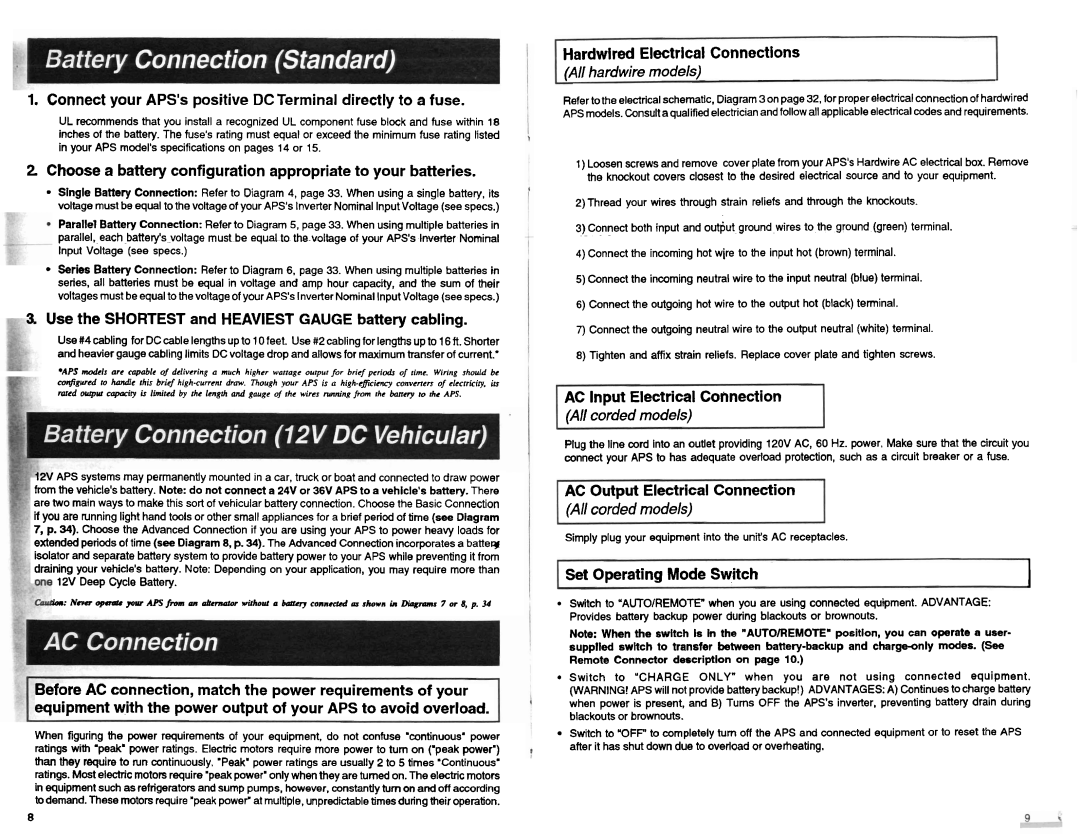
1.Connect your APS's positiveDC Terminal directly to a fuse.
UL recommends that you install a recognized UL component fuse block and fuse within 18 inches of the battery. The fuse'srating must equal or exceed the minimum fuse rating listed in your APS model's specificationson pages 14 or 15.
2Choose a battery configuration appropriate to your batteries.
Single Battery Connection: Refer to Diagram 4, page 33. When using a single battery, its voltage must be equalto the voltageof your APS's lnverterNominal lnputVoltage (see specs.)
Parallel Battery Connection: Refer to Diagram 5, page 33. When using multiple batteries in parallel, each battery'svoltage must be equal to the voltage of your APS'sInverter Nominal lnput Voltage (see specs.)
Series Battery Connection: Refer to Diagram 6, page 33. When using multiple batteries in series, all batteries must be equal in voltage and amp hour capacity, and the sum of their voltages must be equaltothe voltageof your APS'slnverter Nominallnput Voltage (seespecs.)
"Use the SHORTEST and HEAVIEST GAUGE battery cabling.
Use#4cabling for DCcable lengthsupto 10feet. Use#2cablingfor lengths up to 16ft. Shorter and heavier gauge cabling limits DCvoltage drop and allows for maximumtransfer of current.'
'APS models ore ropublc of delivering a much higher worruge ourpur for brief periods o j rime. Wiring should be configured ro W c rhis brief
'., APS systems may permanentlymounted in a car, truck or boat and connected to draw power from the vehicle's battery. Note:do not connect a 24V or 36V APS to a vehicle'sbattery. There are two main ways to make this sort of vehicular battery connection.Choose the Basic Connection if you are running light hand tools or other small appliances for a brief period of time (seeDiagram 7, p. 34). Choose the Advanced Connection if you are using your APS to power heavy loads for extended periodsof time (see Diagram8, p. 34). The Advanced Connectionincorporatesa batteq isolator and separate battery system to provide battery power to your APS while preventing it from draining your vehicle's batteryNote:. Depending on your application, you may require more than
12V Deep Cycle Battery.
h:N s w o p d pur APS fmm an &mator wichoul a b a i f q connecrcd as shown in Diu#mx 7 or 8, p. 34
Pzfore AC connection, match the power requirements of your equipment with the power output of your APS to avoid overload.
When figuring the power requirements of your equipment, do not confuse 'continuous' power ratings with 'peak'power ratings. Electric motors require more power to turn on ('peakpower') than they require to wn continuously. 'Peak'power ratings are usually 2 to 5 times 'Continuous' ratings. Mostelectric motors require 'peakpower'only when they are turned on. The elecbic motors in equipmentsuch as refrigeratorsand sump pumps, however. constantlyturn on and off according to demand. These motorsrequire 'peakpower'at multiple,unpredictabletimesduringtheir operation.
Hardwired Electrical Connections
(All hardwire models)
Refertothe electricalschematic. Diagram3 on page 32, for properelectricalconnectionof hardwired APS models. Consultaqualifiedelectrician and follow all applicableelectricalcodes and requirements.
1)Loosen screws and remove cover platefrom your APS'sHardwireAC electrical box. Remove the knockout covers closest to the desired electrical source and to your equipment.
2)Thread your wires through strain reliefs and through the knockouts.
3)Connect both input and output ground wires to the ground (green) terminal.
4)Connect the incoming hot wire to the input hot (brown) terminal.
5)Connect the incoming neutral wire to the input neutral (blue) terminal.
6)Connect the outgoing hot wire to the output hot (black) terminal.
7)Connect the outgoing neutral wire to the output neutral (white) terminal.
8)Tighten and affix strain reliefs. Replace cover plate and tighten screws.
AC lnput Electrical Connection
(All corded models)
Plug the line cord into an outlet providing 120V AC, 60 Hz. power. Make sure that the circuit you connect your APS to has adequate overload protection, such as a circuit breaker or a fuse.
AC Output Electrical Connection
(All corded models)
Simply plug your equipment into the unit'sAC receptacles.
Set Operating Mode Switch | 1 |
|
Switch to 'AUTOIREMOTE"when you are using connected equipment. ADVANTAGE: Provides battery backup power during blackouts or brownouts.
Note: When the swltch is in the "AUTOIREMOTE'position, you can operate a user- supplied swltch to transfer between
Switch to "CHARGE ONLY" when you are not using connected equipment. (WARNING!APS will not provide battery backup!) ADVANTAGES: A) Continuesto charge battery when power is present, and 8) Turns OFF the APSs inverter, preventing battery drain during blackouts or brownouts.
Switch to "OFF to completely turn off the APS and connected equipment or to reset the APS after it has shut down due to overload or oveheating.
8
